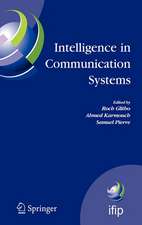Reliabilities of Consecutive-k Systems: Network Theory and Applications, cartea 4
Autor Chung In-Hang, Lirong Cui, F.K. Hwangen Limba Engleză Paperback – 17 sep 2011
| Toate formatele și edițiile | Preț | Express |
|---|---|---|
| Paperback (1) | 641.87 lei 6-8 săpt. | |
| Springer Us – 17 sep 2011 | 641.87 lei 6-8 săpt. | |
| Hardback (1) | 648.11 lei 6-8 săpt. | |
| Springer Us – 30 noi 2000 | 648.11 lei 6-8 săpt. |
Din seria Network Theory and Applications
- 20%
 Preț: 993.93 lei
Preț: 993.93 lei - 18%
 Preț: 954.93 lei
Preț: 954.93 lei - 20%
 Preț: 997.38 lei
Preț: 997.38 lei - 20%
 Preț: 646.62 lei
Preț: 646.62 lei - 20%
 Preț: 650.59 lei
Preț: 650.59 lei - 20%
 Preț: 1290.07 lei
Preț: 1290.07 lei - 20%
 Preț: 657.67 lei
Preț: 657.67 lei - 18%
 Preț: 971.01 lei
Preț: 971.01 lei - 20%
 Preț: 642.19 lei
Preț: 642.19 lei - 15%
 Preț: 642.03 lei
Preț: 642.03 lei - 20%
 Preț: 648.95 lei
Preț: 648.95 lei - 20%
 Preț: 990.12 lei
Preț: 990.12 lei - 20%
 Preț: 1167.50 lei
Preț: 1167.50 lei - 20%
 Preț: 987.17 lei
Preț: 987.17 lei - 20%
 Preț: 993.42 lei
Preț: 993.42 lei
Preț: 641.87 lei
Preț vechi: 802.33 lei
-20% Nou
Puncte Express: 963
Preț estimativ în valută:
122.82€ • 128.58$ • 101.63£
122.82€ • 128.58$ • 101.63£
Carte tipărită la comandă
Livrare economică 05-19 aprilie
Preluare comenzi: 021 569.72.76
Specificații
ISBN-13: 9781461379720
ISBN-10: 1461379725
Pagini: 224
Ilustrații: X, 212 p.
Dimensiuni: 160 x 240 x 12 mm
Greutate: 0.32 kg
Ediția:2000
Editura: Springer Us
Colecția Springer
Seria Network Theory and Applications
Locul publicării:New York, NY, United States
ISBN-10: 1461379725
Pagini: 224
Ilustrații: X, 212 p.
Dimensiuni: 160 x 240 x 12 mm
Greutate: 0.32 kg
Ediția:2000
Editura: Springer Us
Colecția Springer
Seria Network Theory and Applications
Locul publicării:New York, NY, United States
Public țintă
ResearchCuprins
1. Introduction.- 1.1 The consecutive system and generalizations.- 1.2 The problems and the methodologies.- 1.3 Notation.- 2. Computation of Reliability.- 2.1 Recursive equations.- 2.2 The matrix approach.- 2.3 The combinatorial approach.- 2.4 Bounds and approximations.- 3. Design of Optimal Consecutive Systems.- 3.1 Optimal consecutive-2 systems.- 3.2 Invariant consecutive-k systems.- 3.3 The Birnbaum importance.- 3.4 Half-line importance.- 3.5 The combinatorial importance and the rare-event importance.- 3.6 Consecutive-k G system.- 4. The Lifetime Distribution.- 4.1 Mean time to failure.- 4.2 Estimation of Parameters.- 4.3 Increasing failure rate preservation.- 4.4 IFR property for k ? 4.- 5. Asymptotic Analysis.- 5.1 Elementary method.- 5.2 Generating function method.- 5.3 Poisson convergence method.- 5.4 The dependence models.- 5.5 Distribution for exchangeable lifetimes.- 6. Window Systems.- 6.1 The k-within-consecutive-m-out- of-n system.- 6.2 The (2, m, n) system.- 6.3 b-Fold-window systems.- 6.4 Asymptotic analysis.- 7. The Network Model.- 7.1 The linear consecutive-2 network system.- 7.2 Connectivity and hamiltonian reliability.- 7.3 The reversible model.- 7.4 The k ? 3 case.- 8. Consecutive-2 Graphs.- 8.1 Reliabilities of consecutive-2 graphs.- 8.2 Optimal consecutive-2 graphs: general theory.- 8.3 Invariant d-nary trees.- 8.4 Other consecutive-2 graphs.- 8.5 The 2-dimensional case.- 9. Some Related Systems.- 9.1 Consecutively connected systems.- 9.2 Multi-failure consecutive systems.- 9.3 Redundant consecutive-k systems.- 9.4 Weighted consecutive systems.- 10. Applications.- 10.1 Examples of modelings.- 10.2 Application examples with computations.- References.
















